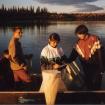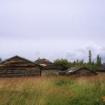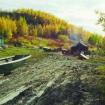By Uses
Puffballs
As medicine
The brown powder inside the puffballs fungi is used to treat weeping sores when there are no bandages to cover the area. The powder is also used on burns when the blister has broken and the burn area is weepy. The powder is dusted over the affected area. It will dry the area so infection does not set in.
Source: Andre, Alestine, Nan t'aih nakwits'inahtsìh (The Land Gives Us Strength) (2006)
Birch and Willow fungus
Yarrow
As medicine
Wormwood
Wintergreen
As medicine
Ruth Welsh’s mother taught her to use wintergreen or large-flowered wintergreen for pain. The leaves of this plant can be used all winter. Ruth said,
...you know where [the wintergreen] patches are and you dig the snow away, brush the last of the snow away from the plants, and you can still pick the leaves.
Silverweed
It thickens the blood and it's a coagulant...therefore when you're bleeding pretty good, you drink the tea from this, or if you suspect internal bleeding and you don't have the yarrow...
Rhubarb, wild
As food
The picking time for this plant lasts only about two weeks. The rhubarb plant is ready to eat in mid-June when it is about 20 to 25 centimeters tall (eight to 10 inches). When the plant is young it can be eaten raw, after first removing the leaves and seedy tops from the plant, and peeling off the outer skin. It is very crunchy and juicy. Once the plant has gone to seed or has many white flowers, the plant is too dry to eat.
Plantain
As medicine
The leaves of the plantain plant are made into a poultice as a painkiller for cuts and bruises and the above ground part of the plant is made into a tea to soothe burns. A leaf that is large enough to cover a cut is used. Fresh leaves are preferred because Ruth said,
When you dry them in the winter, they will [turn to] powder. But you can also make a poultice out of that and do the same thing.
Ruth added,



